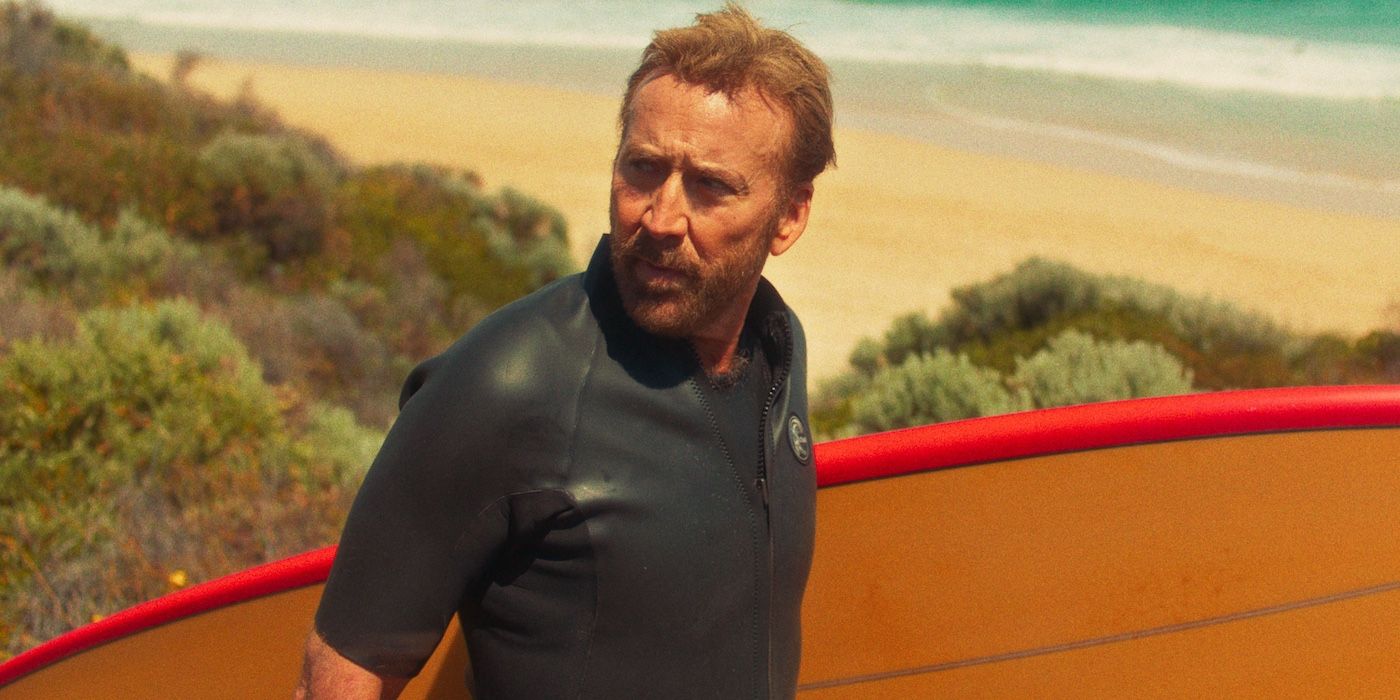
The resurgence of Nicolas Cage, which began in 2021 with the movie “Pig,” shows no signs of slowing down. In the film “The Surfer,” directed by Lorcan Finnegan, Cage portrays a father who yearns to purchase his childhood home and surf with his son. However, this idyllic dream soon turns into a nightmare as the main character is obstructed from reaching the beach by a gang of young locals led by internet mogul Scott Callahan (played by Julian McMahon). Not only are they preventing him from accessing the shoreline, but also subjecting him to continuous harassment, stalking, and torment.
Against the scenic backdrop of Luna Bay, Cage’s character finds himself stripped bare by a game of cat and mouse. He loses his surfboard to theft, trades his ring for a phone call, gives away his watch for coffee, drains his phone battery, and even has his car stolen by the boisterous locals during the night. In essence, this is one method of dismantling a character.
However, the descent doesn’t end there. Cage’s initially peaceful lifestyle succumbs to his growing obsession. At various instances throughout this harrowing journey, he had the chance to concede and depart. Abandoning this path would have also meant relinquishing his hope for a solution to all his troubles – acquiring a house on Clifftop Drive. Despite the opportunity to leave, he chooses to resist in the Luna Bay parking lot, eventually collapsing in the process. This decisive moment is what sets this movie apart as an engaging psychological thriller.
In this movie, The Surfer is presented as someone who seems detached from life’s fundamental truths. He starts off driving a luxury car with his son, engaging in casual conversations with bankers and investors, and wearing a Rolex watch even while surfing the waves (this act, in particular, demonstrates a careless wealth). However, beneath these ostentatious signs of affluence lies a man on the verge of collapse.
The Surfer’s Worst Enemy Might Just Be the Setting
In this story, actor Finn Little portrays a character called The Kid, who is the son of a surfer. Over time, we notice that The Kid appears to be pulling away emotionally from his father. To add to his troubles, his former wife is expecting a child with another man, which he finds difficult to accept.
The main lesson in this story is that material possessions have little value when it comes to true happiness. Despite this truth being evident, the protagonist refuses to acknowledge it and instead becomes increasingly fixated on acquiring something else to fill the growing void of his past.
However, what he once easily acquired with money has transformed into a formidable obstacle that he refuses to abandon, even as the circumstances grow increasingly unbearable. Audiences find themselves captivated because Nicolas Cage’s performance during these scenes of humiliation is both mesmerizing and unsettling.
In simpler terms, the townsfolk behave like wild creatures intent on disrupting the Surfer’s mental peace. Interestingly, the small parking lot where the main character stays acts as a silent adversary. The harsh and blurry environment tests the Surfer through numerous physical challenges. As he moves closer to his objective (recovering his surfboard, symbolizing his past), hunger, thirst, and danger become persistent obstacles. Animals pose threats to his life. The intense heat and humidity leave him disoriented. Beneath the surface of human conflicts within the town, the struggle between man and nature elevates the film to a deeper thematic level.
Bringing One’s Inner Conflict to Life in ‘The Surfer’
In his desperate struggle to maintain equilibrium in life, The Surfer finds himself pursued by a snake and attacked by a potentially edible rat. He resorts to drinking water from questionable sources such as a restroom sink and a street pothole. This grueling ordeal can be seen as a form of torment reminiscent of prison life. The movie’s structure is intriguing, with The Surfer moving from one precarious situation to another within the confines of a single location. Despite the harshness and bareness of his surroundings, they serve as stepping stones guiding him towards various destinations. From this vantage point, The Surfer can simultaneously see both the distant dream he yearns for and the immediate challenges he faces, much like having a bird’s eye view of reality. Even a bleak setting like a parking lot can be an imaginative avenue leading to new possibilities.
In this intriguing scene, there appear to be two distinct paths. Neither offers a straightforward escape. The skilled cinematographer, Radek Ladczuk, masterfully uses camera angles to heighten the suspenseful narrative. One path is a labyrinthine stairway-laden route leading to Clifftop Drive, currently inaccessible for our protagonist due to his current mental confusion. The other path involves a grueling ritual where the water and waves serve as both a symbolic reward and a necessary spiritual aid for him to overcome his present burden of guilt.
Read More
- 50 Ankle Break & Score Sound ID Codes for Basketball Zero
- Stellar Blade x Nikke DLC: Full Walkthrough | How to Beat Scarlet + All Outfit Rewards
- 50 Goal Sound ID Codes for Blue Lock Rivals
- Sony Doesn’t Sound Too Concerned About Switch 2, Even After A Record-Breaking Debut
- Mirren Star Legends Tier List [Global Release] (May 2025)
- League of Legends: Bilibili Gaming’s Epic Stomp Over Top Esports in LPL 2025 Playoffs
- League of Legends: Anyone’s Legend Triumphs Over Bilibili Gaming in an Epic LPL 2025 Playoff Showdown!
- Lucky Offense Tier List & Reroll Guide
- Labubu’s popularity has made its owner China’s youngest billionaire
- 100 Most-Watched TV Series of 2024-25 Across Streaming, Broadcast and Cable: ‘Squid Game’ Leads This Season’s Rankers
2025-05-04 23:03